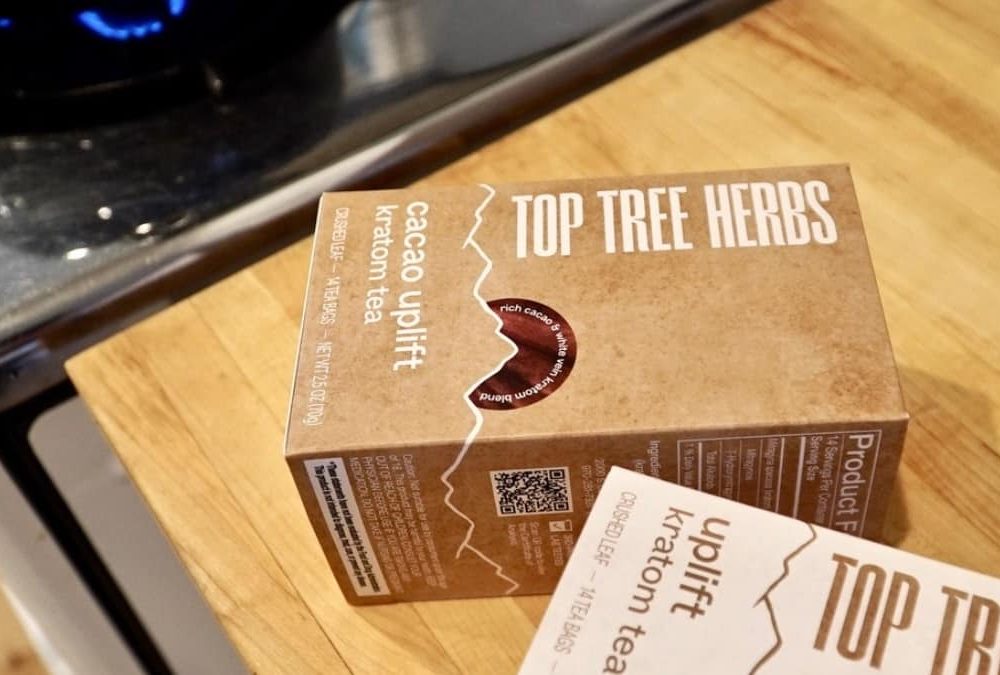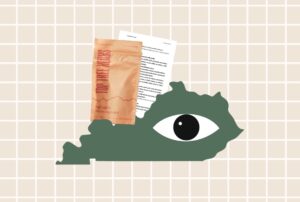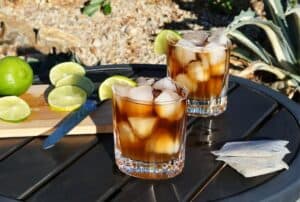White Maeng Da Kratom is one of the most popular and well known varieties of kratom available. Batches named White Maeng Da are typically stronger than other white vein kratom strains. though this statement comes with a caveat, which we’ll cover at length below.
So for most people, White Maeng Da kratom is a go-to for starting your morning. When you have white vein kratom as a tea, it’s an especially great alternative to coffee.
Let’s dive into White Maeng Da kratom types, alkaloid contents, and effects so you can figure out what all of the hype is about for yourself.
What is Kratom?
Kratom is the Thai word for an evergreen tree, Mitragyna speciosa, and its leaves. Kratom trees are relatives of coffee plants (Coffea arabica, Coffea caniphora, and the like). Both are in the Rubiaceae family of plants.
This tree has been consumed for hundreds of years throughout Thailand, Indonesia, and other nearby countries and islands in Southeast Asia. Frequently, it is used by Thai laborers: they chew on the fresh leaves or brew them into a tea to get the effects of the alkaloids and other compounds contained in the leaves. The tea leaves sustain their energy levels while they’re farming in the hot sun for hours each day.
In the US, kratom has gained a lot of popularity among white and blue collar workers alike. The energizing effects are great for those looking to reduce their caffeine intake yet maintain strong energy levels.
Why is White Maeng Da Most Frequently Found in Powder Form?
Since coming to the United States, kratom has undergone a number of revisions from it’s traditional form. Due to the high cost of shipping kratom from Southeast Asia to the US, most kratom in the states is a fine powder, loose or in capsules.
Kratom consumption in the United States revolves around the practice of tossing and washing the micronized powder. Many companies also make kratom extracts from this powder. Thus, the reason that powder is so widely available isn’t simply because it’s better product. It’s in large part because it’s cheaper to transport.
Though kratom tea has been brewed for hundreds of years and is a tried-and-true method of preparing kratom, it takes a bit more effort and money to ship it. Crushed-leaf kratom is less dense than the powder, so the same weight takes up more volume when shipping. Kratom tea is a great product for numerous reasons, but has only just started rising in popularity in America recently.
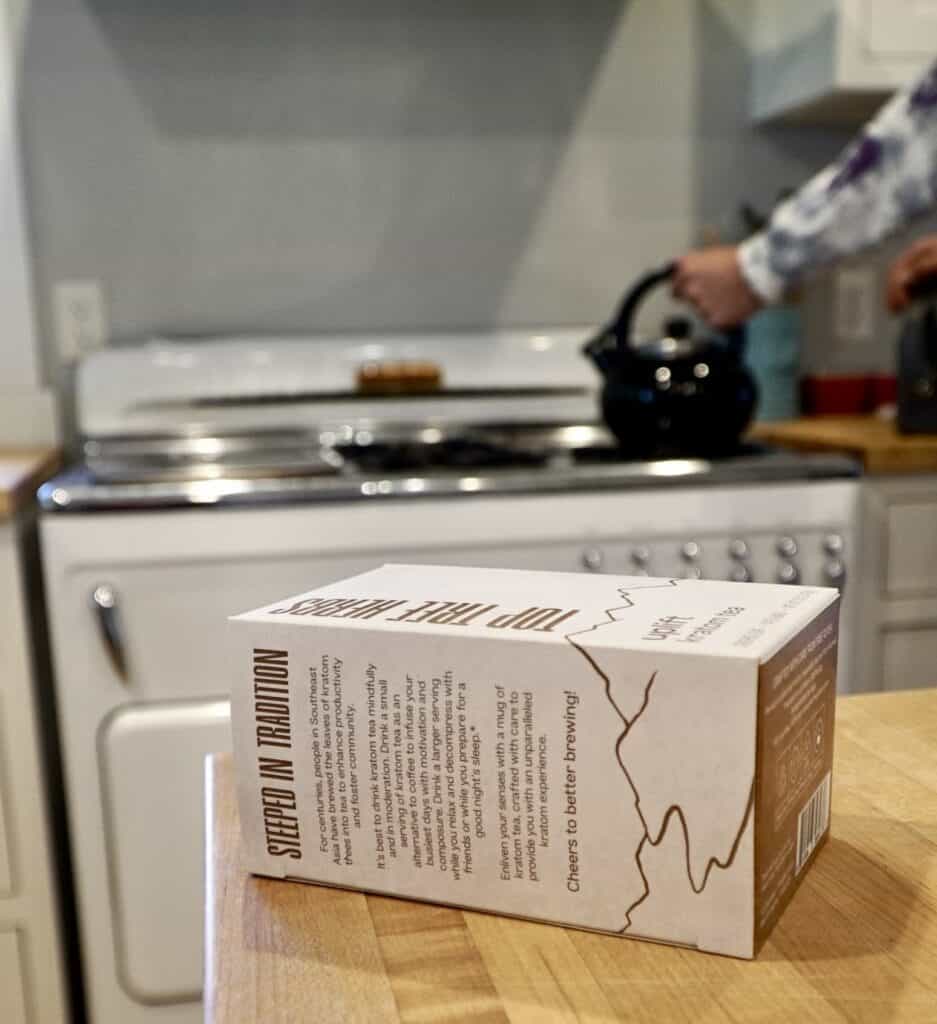
Since kratom is predominantly sold as a powder to consumers without much (if any) information about the centuries-old traditional practices, US consumers are left in the dark. They end up swallowing the powder with some water or orange juice, finding and means possible to make it taste better or just get the process over with as quickly as possible.
In our view, kratom tea is a much better way to use kratom throughout the day. Remember, traditional kratom leaf was never actually swallowed. The leaves were either chewed and spat out, or steeped into a tea.
Now that we have a better idea of why most White Maeng Da you’ll find from kratom companies is in powder form, let’s cover the specific benefits of various forms of White Maeng Da kratom. What’s the difference between Maeng Da kratom and other strains of kratom? Is White Maeng Da is the best kratom tea for energy?
What is White Maeng Da Kratom?
White Maeng Da kratom is a white vein kratom variety. Other common kratom varieties include red vein and green vein. To further distinguish between kratom of different vein colors, many vendors will use kratom “strains.”
Maeng Da is one of many strains, and possibly the most popular strain of kratom within the white vein category. “Maeng Da” is a Thai slang phrase used to denote excess. It literally translates to “pimp grade.” In other words, it is like the informal English phrase, “that’s some good sh*t!”
In most cases, there’s no particular type of leaf—old or young leaves, larger or smaller ones, leaves with a certain color, or a particular alkaloid profile—that constitutes the Maeng Da strain (or any other strain, for that matter).
Alkaloid Content of Maeng Da Kratom
Sometime strain names are based on the kratom’s alkaloid content, and sometimes they are arbitrary, and are just used for marketing and sales purposes. So instead of referencing the genetic makeup of a specific variety of kratom tree, strains are typically a subjective grading scale used to denote strength.
A number of kratom companies call high-alkaloid varieties of white vein kratom White Maeng Da. Unlike its cousin coffee, kratom doesn’t have any caffeine. Nevertheless, kratom leaves with a high alkaloid content are often used in herbal teas for those looking for energizing, refreshing, and uplifting effects.
Typically, the best batch from every harvest is called the Maeng Da strain, and there’s usually one Maeng Da option for each vein color. Despite what some vendors claim on their websites, kratom trees do not produce a consistent amount of alkaloids in set proportions.
The concentration of varying alkaloids vary depending:
- When the leaves were harvested
- How much sun they receive
- The soil nutrient content
- Threat of predation
- The presence of endophytic fungi
- And other environmental factors
Thus, like all plant material, it is impossible to sustain a consistent amount of each alkaloid from batch to batch. Though Maeng Da kratom may consistently stronger than other strains, you can’t expect perfect consistency from batch to batch.
There are a lot of White Maeng Da kratom varieties to choose from. Most kratom companies offer Maeng Da powder or capsules, though the powder can have some drawbacks. You can also find strong white vein kratom as a tea, which can be a better form of kratom depending on your preferences.
More on the Myth of Strains
In mid-2023, Top Tree Herbs decided to stop using Maeng Da and other strains names to categorize its tea. Because there’s no scientific method for determining which strain a particular kratom batch is, we found that the effects of “strains” were highly inconsistent between companies and batches. Strains didn’t accurately represent what the benefits of certain types of kratom would be. Further, studies have shown that the feeling of a particular kratom strain is largely related to marketing and subjective perception.
So if kratom strains are so subjective and unreliable, how did they take hold as one of the primary factors people consider when buying kratom in the US?
Now that we understand what “maeng da” means, let’s dig into the misconceptions surrounding strains a little more. In brief, kratom comes in three distinct kinds. Each is named after the color of the leaf. Basically, there is green vein, white vein, and red vein. As we’ve written about in past blog posts, kratom strains are a largely invented category utilized to market and sell kratom to westerners unfamiliar with the tree.
In the wild, kratom trees all grow similarly colored leaves. For example, in our greenhouse nestled in the Appalachian mountains, our leaves are all dark green with a rusty red vein running down the center. Regardless of where you are, to get the distinct green, white, and red coloration, the leaves are left after harvest to ferment for a few days to a couple weeks. The longer the leaves stay in the bags, the darker red they become.
In some instances, white veins are produced via a longer drying process with little to no fermentation. Likewise, green veins often undergo little “processing” following harvest.
If you’ve been in the kratom space for a while, you’ll have heard of the simple color-based categorization and the associated effects. White veins are recommended for energy. Red veins are known as the best kratom strain for sleep, and make for a great sleepytime time tea. Typically, greens fall somewhere in between. People seek them out for their balanced uplifting elements.
In truth, vein colors offer only a partial window into the effect of the particular variety of kratom. Spectrometry tests are needed to accurately and consistently determine the alkaloid content of a batch of kratom leaves.
Kratom Strains that are Named After Growing Regions
In most cases aside from Maeng Da, kratom strains are named after a country or region. For example, companies may say that their Borneo strains are grown in Borneo, Bali kratom is grown in Bali, Sumatran kratom in Sumatra, and so on.
Most kratom found in the US today, however, is imported from one particular area of Indonesia on the island of Borneo. Because of this, we’re always a little suspicious of vendors that have 50+ strains from around the world.
Even though most kratom comes from one region in Borneo, there are some interesting differences in batches of kratom that all come from these trees. Within one region, there may be seasonal and geographic differences in soil conditions, weather patterns, sunlight exposure, and other environmental factors which affect alkaloid production. There may even be distinct genetic qualities for nearby locations, although that hasn’t been well-explored in the scientific literature.
Overall, you will still find distinct differences between different harvests, even if they are from the same location. Plus, since strains like White Borneo, White Thai, or White Maeng Da kratom are all categorized via arbitrary or subjective assessments, i.e. their strength, the region they are grown in is less important.
A Broad Overview of Kratom Alkaloid Percentage
As we’ve mentioned earlier in this post, the most important distinguishing factor (that we’re currently aware of) when it comes to determining the effect of a kratom strain is its alkaloid makeup.
Commonly, you’ll hear about two important alkaloids: mitragynine and 7-oh-mitragynine (7-OH). Mitragynine is the most abundant alkaloid in kratom leaves. As a result of its abundance, many people buy kratom based on just the mitragynine concentration, and don’t consider any of the other compounds in the leaves.
This tendency, however, has recently become disputed. Kratom researchers are now looking into the often-overlooked strengths of the 40-plus kratom alkaloids.
7-OH-mitragynine is found only in trace quantities in kratom leaf. Its increased potency, however, has brought it to the forefront of many kratom consumer’s minds. A little bit of 7-OH goes a long way.
Still, these two alkaloids can only go so far in painting the picture of the effects one will get from kratom. Over 40 different alkaloids have been discovered in kratom plants. Most are found in trace quantities, and not every kratom tree produces every alkaloid.
Together, there is reason to believe that they exert an entourage effect. Some alkaloids may potentiate others by slowing metabolic processes or by competing for neuronal receptor sites.
Top Tree’s Kratom Research & Survey Work
We are strong believers in the need for further research and understanding of kratom alkaloids. This is the reason we paired up with Dr. Oliver Grundmann to conduct a survey of kratom tea drinkers and determine the alkaloid profile of Top Tree’s kratom tea (specifically, the batches that were available at the time of the study).
The survey was paired with a groundbreaking test to determine the concentrations of the eight major alkaloids found in kratom leaves. So, we were able to pair the reports of strain effects from hundreds of kratom tea drinkers with the results of the eight-alkaloid panel for each strain.
In our White Maeng Da kratom tea bags from 2021, we tested for eight alkaloids. Those alkaloids are: mitragynine, paynantheine, speciogynine, speciociliatine, 7-OH-mitragynine, mitraphylline, isorhynchophylline, and corynoxine. See the photo at the top of the blog for the average amount of alkaloids contained in each 3 gram tea bag.
White Vein Kratom Tea Options
Unlike other kratom vendors, we have more than just White Maeng Da kratom micronized powder. In fact, we don’t carry any loose powder! At Top Tree, we’ve created our products with great consideration for traditional knowledge. Since you don’t traditionally consume any part of kratom leaves, we make our white vein teas with crushed-leaf kratom in tea bags.
Instead of the subjectively named White Maeng Da, we now offer Uplift, a raw leaf white vein kratom tea variety that changes slightly with each batch, just as other kratom strains would.
We also offer Cacao Uplift, which is a blend of our white vein kratom tea and organic cacao shells. Cacao Uplift has a rich toasted flavor. Once you try it with a splash of your favorite coffee creamer, it’ll become your go-to morning brew—no coffee needed!
These options are similar to our past White Maeng Da kratom tea options, but we don’t give them the name Maeng Da anymore. We’re dedicated to transparency and improving the kratom industry through education, so we’re moving away from the misleading practice of using strain names.
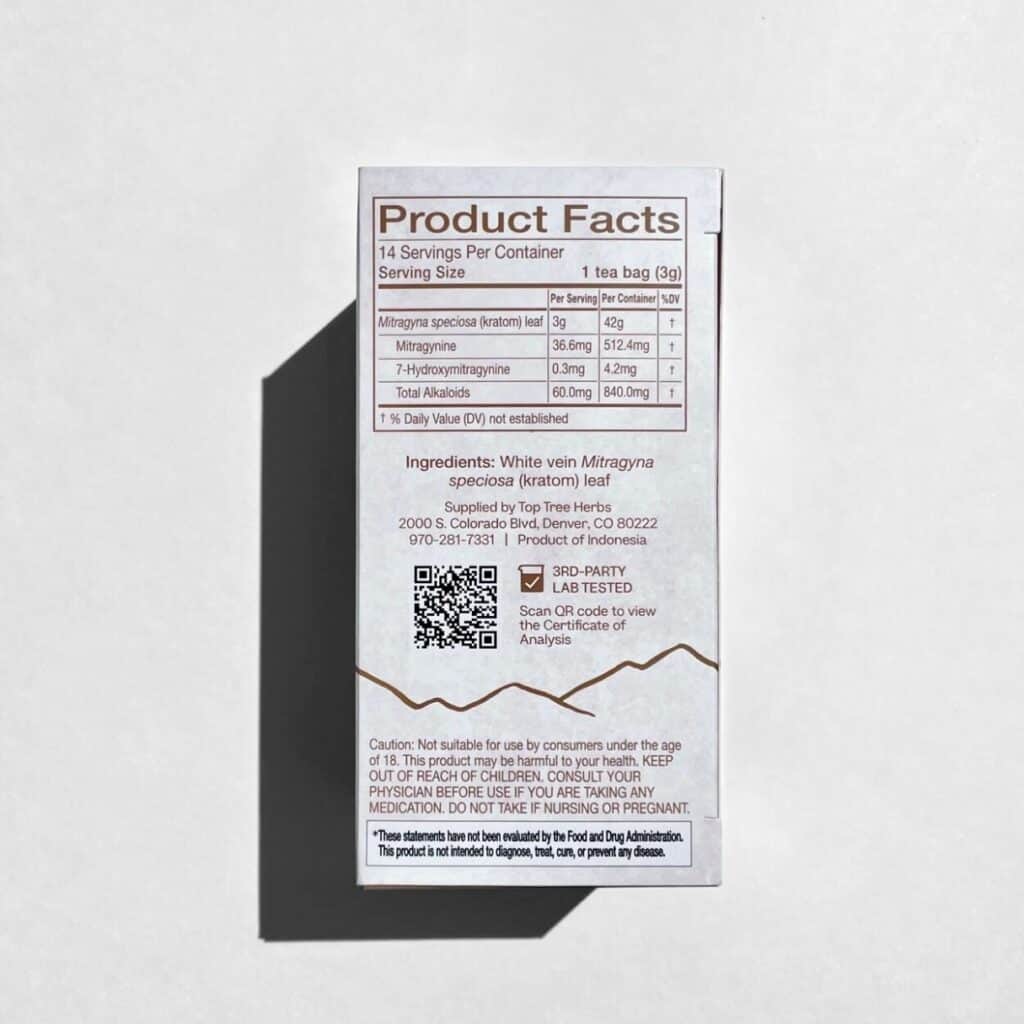
Instead of a strain name, you’ll find the mitragynine and 7-OH-mitragynine concentration right on the box, and a QR code link to our kratom CoAs with even more alkaloid and contamination testing results.
White Maeng Da Effects and Serving Sizes
As we’ve mentioned, White Maeng Da kratom is generally marketed as being uplifting and energizing. As a consequence, it’s a popular variety among kratom enthusiasts looking for a strong morning tea or pre-workout drink.
With kratom tea bags, you can steep the same 3g tea bag again for a second slightly lighter cup of tea. This means that one cup will be a little weaker than the equivalent amount of kratom leaf powder swallowed.

However, after your second steep, most of the alkaloids should be out of the leaf and into your water. After drinking the second steep, your kratom tea effects can be just as strong as any other kratom preparation.
That’s why we’ve used White Maeng Da and other white vein varieties for our morning-oriented teas and blends in the past.
Best Way to Consume Kratom
Brewing kratom tea is different from brewing your typical Camellia sinensis tea. There is a unique brewing process for kratom tea. Regardless of the alkaloid concentration of your crushed-leaf kratom—whether it’s Maeng Da or another variety—you can brew it according to the steps below to optimize the effects.
For starters, you should always use lemon juice or another form of food-safe acid. Some people use lime juice, apple cider vinegar, vitamin C, and even citric acid isolate. An acid is needed to make the kratom alkaloids more water-soluble. Once mixed with an acid the alkaloids can more easily leave the kratom leaf and mix with the water.
- Add tea bags and lemon juice to thermos: We recommend that you first put your tea bags into your thermos and then add your lemon juice. At Top Tree, we like to use one to three tea bags with a tablespoon of lemon juice concentrate or the juice of half a small lemon.
- Boil water: While the lemon juice saturates the tea bags, bring your water to a boil.
- Steep tea: Once boiling, pour your water over your tea bags and cap your thermos. Steep your tea for 20 minutes.
- Add sweetener if desired: add your sweetener of choice (and any other ingredients you’d like, such as mint leaves), let it cool, and enjoy!
PRO TIP: You can repeat this process 1 or 2 times with the same tea bags before tossing them in the compost. Our tea bags are all biodegradable!
Conclusion
You might have started reading this article with the assumption that White Maeng Da kratom is a singular type of kratom with a set alkaloid profile and/or effects. We know it’s a bit confusing to wrap your head around the reality of how strains are determined, and the complex and helter-skelter myths surrounding them. Nonetheless, we hope you now better understand the structure of kratom naming conventions.
In truth, the most important thing to consider when picking strains for effect is the alkaloid content. That’s why we provide you with the results of our alkaloid testing for each batch of tea, and only use vein colors to categorize them.
At Top Tree Herbs, we’re proud to sell white vein kratom tea instead of White Maeng Da and other strains of kratom. We hope you have a great time exploring our new strainless kratom teas, and learning about strains from a new perspective. Until next time, cheers to better brewing!
